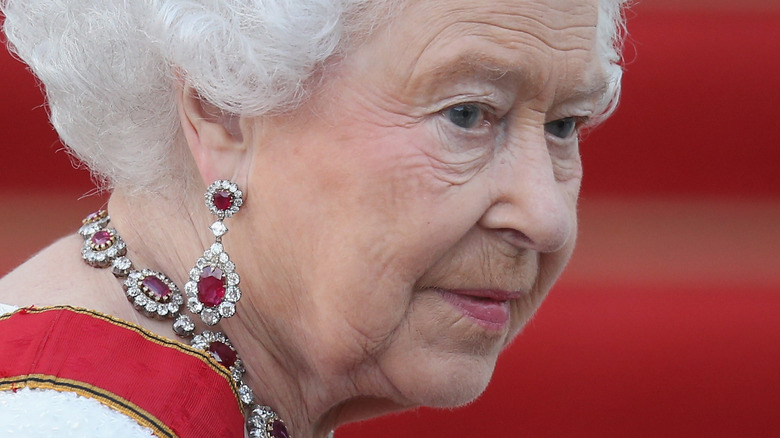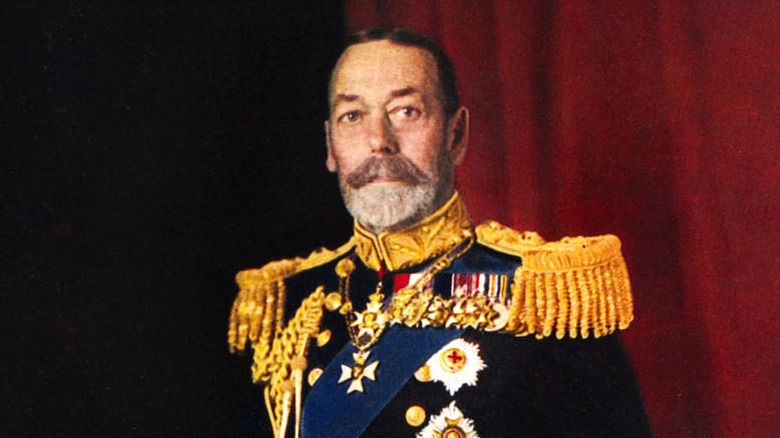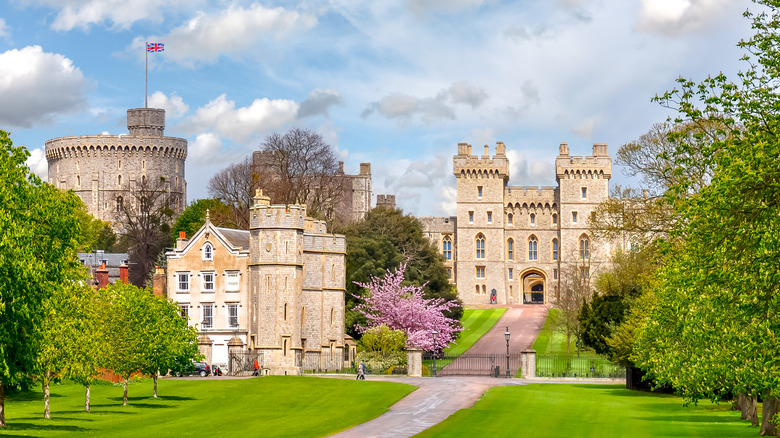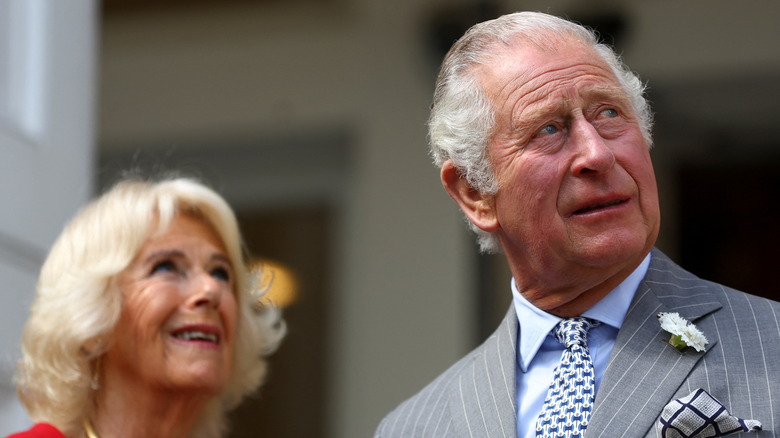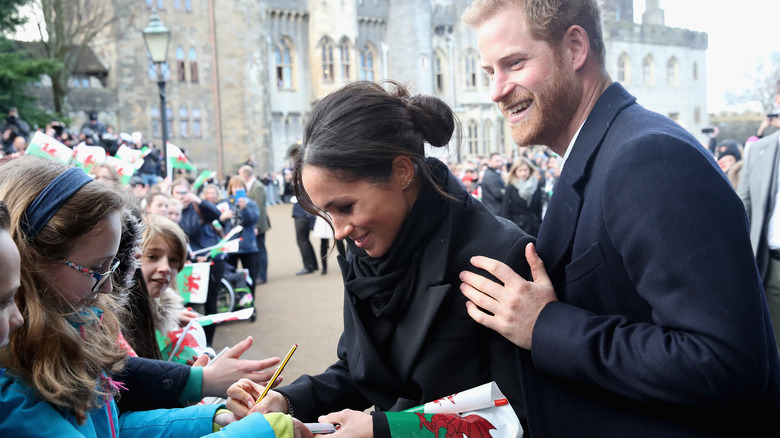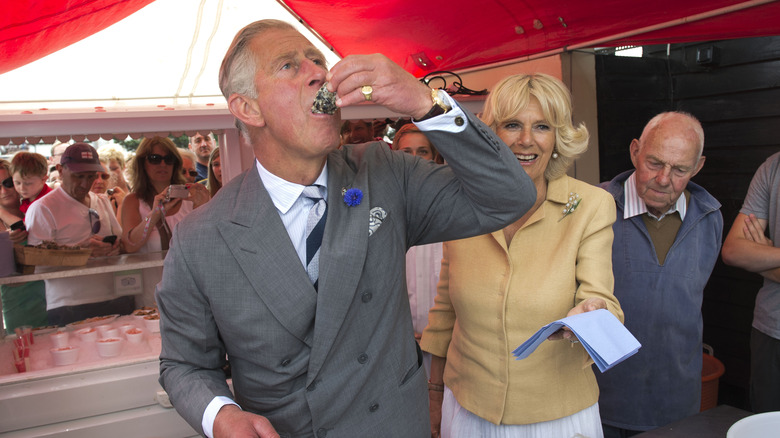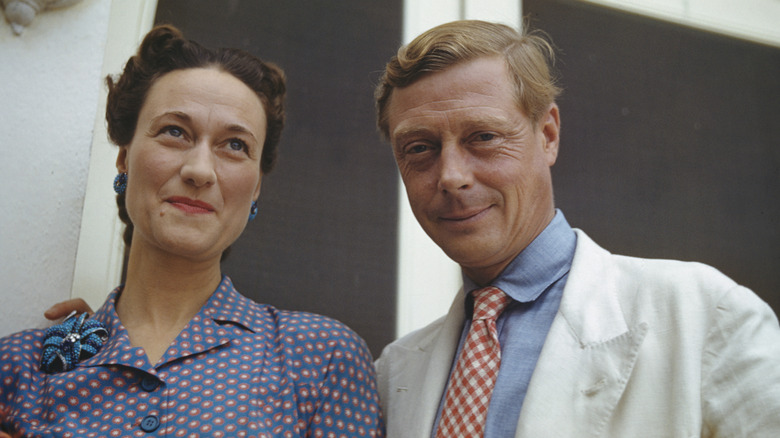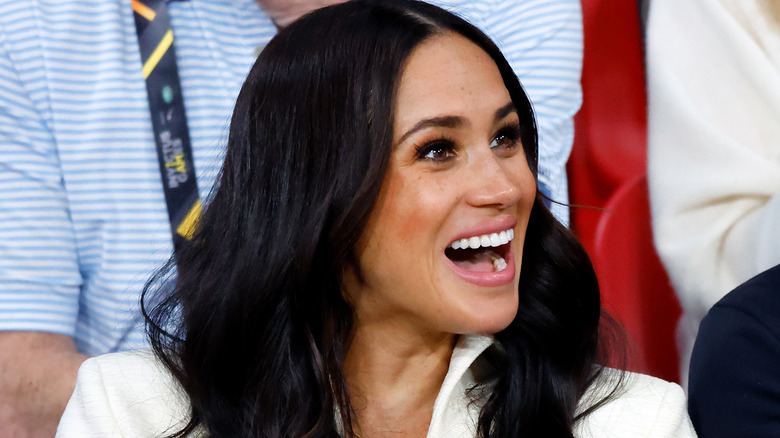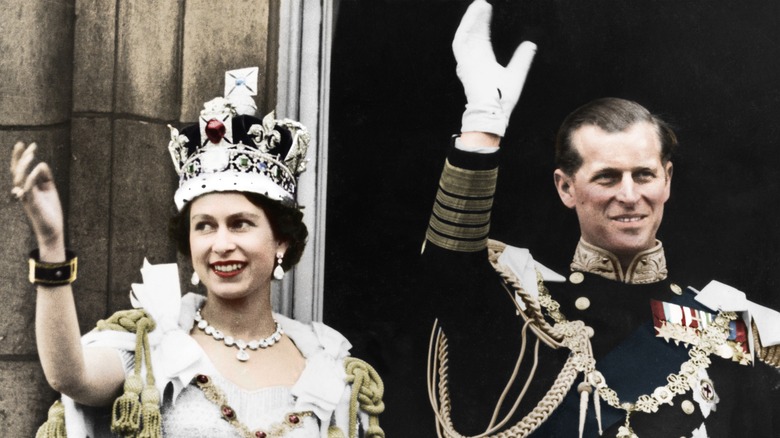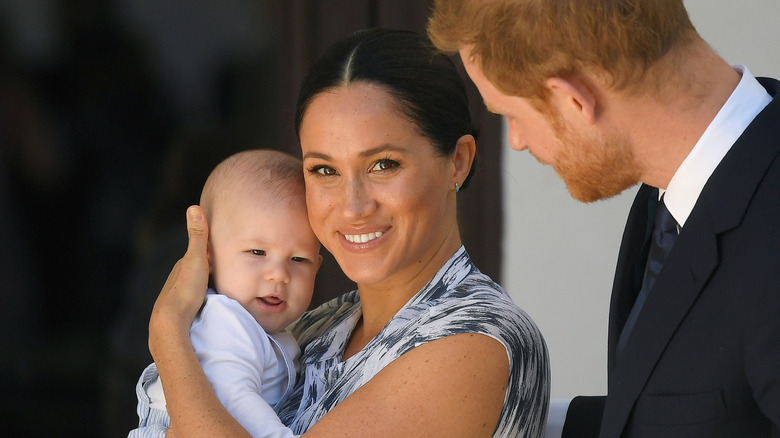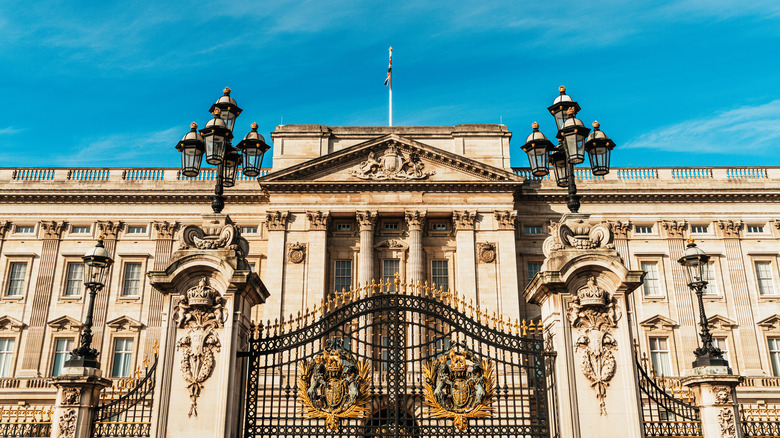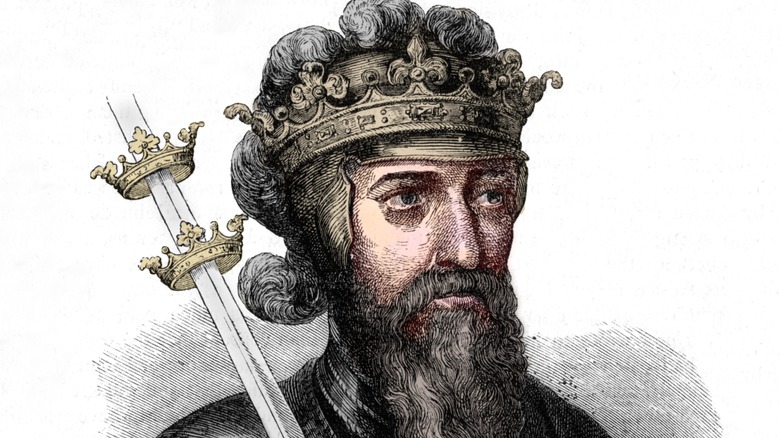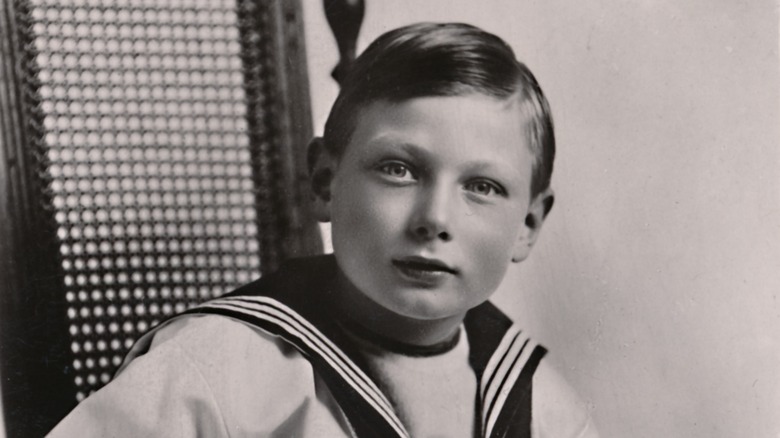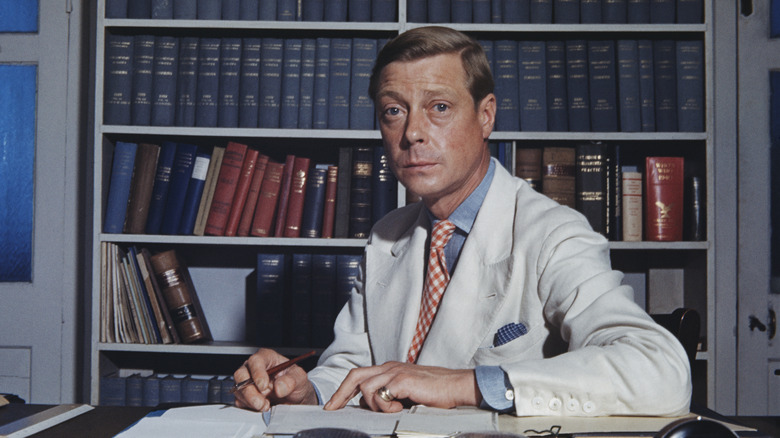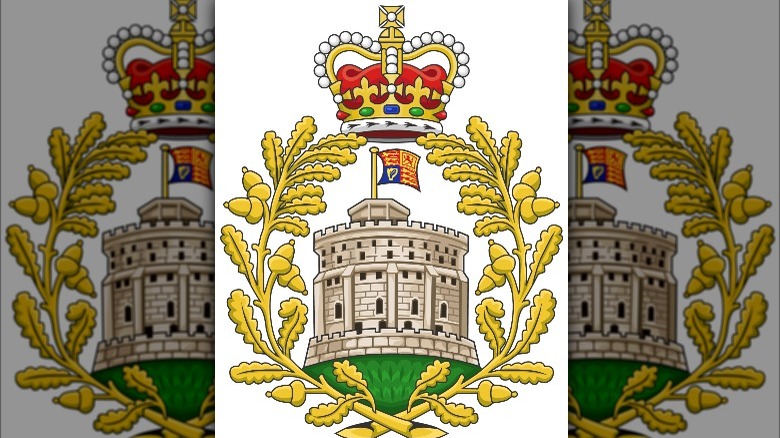The Untold Truth Of The House Of Windsor
As any royal watchers worth their salt are well aware, Britain's royal family are members of the House of Windsor, a royal bloodline with a long and complex history that has woven its way throughout European aristocracy for centuries. As Queen Elizabeth II celebrates her Platinum Jubilee to mark 70 years on the throne, this venerable royal house is once again in the spotlight as a new monarch, Prince Charles, is poised to take over when his nonagenarian mother shuffles off this mortal coil, to paraphrase Shakespeare. Then will be heard a famous phrase that hasn't been uttered since the death of Queen Victoria: "The queen is dead, long live the king."
While members of the House of Windsor — including Prince William and wife Kate Middleton, and brother Prince Harry and his wife, Meghan Markle — continue to make headlines throughout the world during this time of royal transition, the average non-royal may not know as much as they might imagine about the history behind the royals' family name.
To find out more, keep reading to discover the untold truth of the House of Windsor.
The House of Windsor is actually German, not British
While the House of Windsor is immediately associated with the British Isles, the truth is far more complicated.
Prior to the first World War, the family name of Britain's royals was not Windsor, but something far more Germanic: the House of Saxe-Coburg-Gotha. As the Royal Family website explains, that House was imported to England when Queen Victoria (whose dynastic origins were from the House of Hanover) married Prince Albert, son of Ernst, Duke of Saxe-Coburg & Gotha, a German house. Victoria's grandson, King George V, was monarch when the outbreak of World War I led to an avalanche of anti-German sentiment throughout Britain.
To counter this, in 1917, the King issued a proclamation decreeing that what had been the House of Saxe-Coburg-Gotha was now renamed the more-anglicized House of Windsor, with all future descendants also taking on the name. In addition, the King's proclamation also determined that all members of this newly named house would "relinquish and discontinue the use of all German Titles and Dignities." The original Saxe-Coburg-Gotha name lives on, however, in some other European monarchies, including the royal family of Belgium and the now-defunct monarchies of Bulgaria and Portugal.
Windsor Castle predates the House of Windsor by centuries
When the House of Saxe-Coburg-Gotha was renamed, its new moniker was lifted from one of British royalty's most storied pieces of real estate: Windsor Castle, situated just outside of London. According to the Royal Collection Trust, Windsor Castle was constructed for William the Conqueror in the 11th century and has since been home to 39 British monarchs. Throughout her reign, Windsor Castle has been Queen Elizabeth's weekend getaway; in March 2022, The Times reported that the 95-year-old monarch would be making the castle her home base and new official residence, which had previously been London's Buckingham Palace.
Interestingly, Windsor wasn't the only name under consideration when George V sought a non-German replacement. According to the six-part documentary series "The Royal House of Windsor," the king outsourced the task to his private secretary, Lord Stamfordham (via the Daily Mail). As he delved through history books, Lord Stamfordham couldn't help but notice that some of the other names most famously associated with the British monarchy — including Tudor, Plantagenet, and Stuart — shared histories drenched in bloodshed and beheadings. He came up with the eventual name while working in Windsor Castle, and the rest is history.
Before the House of Windsor, British royals didn't use last names
Prior to the introduction of the House of Windsor, British royals didn't use last names, a tradition that remained in place when King George V issued his proclamation officially changing the original Saxe-Coburg-Gotha name.
As the Express recalled, when Elizabeth II became monarch in 1952, she made a small amendment to the proclamation that also made Windsor the official family surname. When she married Phillip Mountbatten (whose family name had similarly been anglicized from the original Battenberg), their descendants would carry the surname Mountbatten-Windsor.
While British royals are now granted permission to use a surname, the choice of whether or not to use that surname remains optional; some royals use them, some don't. Some, in fact, have chosen to use their territorial designation instead; that was the case when Princes William and Harry served in the military, with both choosing to use the surname Wales in deference to their father's official title, Prince of Wales.
The Windsors aren't supposed to ever sign autographs
While each member of the House of Windsor can make the individual choice of whether or not to use a surname, one thing they are never supposed to do with that name is sign it for a fan. A longstanding royal rule, reported MyLondon, prohibits royals from signing autographs; the reason, understandably, is to avoid the risk of their signatures being forged.
Of course, there have been exceptions. Prince Charles famously broke the rule back in 2010 when he signed "Charles 2010" for the survivor of a catastrophic flood. Typically, however, Charles will respond to an autograph request by declaring, "Sorry, they don't allow me to do that."
Another royal who broke with protocol was Meghan Markle. As People reported, several months before her 2018 wedding to Prince Harry, she signed an autograph for a young fan in Cardiff, Wales. According to the magazine, the future Duchess of Sussex technically didn't break the rules. For one, she hadn't yet married into the House of Windsor, and was not yet an official royal. For another, she didn't sign her name, but instead signed the name of the youngster receiving the autograph, Caitlin Clark, writing simply, "Hi Kaitlin" (and yes, she misspelled the kid's name).
Members of the House of Windsor are forbidden from eating shellfish
Among the many rules by which members of the House of Windsor must abide — and there are indeed many — are those involving what foods British royals are permitted to eat. One rule forbids royals from consuming is uncooked shellfish. As BBC News explained, the reason is quite simple: Oysters, clams and the like, when consumed raw, may be delicious, but also carry an outsized risk of food poisoning and possibly upsetting royal tummies. When traveling, in fact, so as not to interrupt schedules due to intestinal distress, other foods that are banned for Windsors include rare meat, tap water that would be foreign to them, and any type of cuisine deemed to be excessively spicy or "exotic."
"It is a very sensible move to abandon having seafood when out and about on public duties," said former royal butler Grant Harold, via the Express. "We don't want a member of the Royal family having a serious reaction to food poisoning, especially if they're on an overseas tour."
Leave it to Prince Charles to buck with tradition and throw caution to the wind, as he did when he slurped up an oyster while attending the 2013 Whitstable Oyster Festival.
The House of Windsor has seen more than its fair share of scandals
When the Queen famously declared 1992 to be her "annus horribilis," (which roughly translates from Latin to English as "garbage year"), she wasn't exaggerating. After all, as Australia's ABC News pointed out, that particular 12-month span brought the announcement that Prince Charles and Princess Diana were separating, Sarah Ferguson's split from Prince Andrew— and that subsequent photo of a Texas millionaire sucking on her toe), and all the associated scandals that kept tumbling out after that.
Subsequent decades kept the scandals coming, both large and small, ranging from teenage Prince Harry dressing like a Nazi for a costume party to Prince Andrew's association with notorious convicted pedophile Jeffrey Epstein, and then being sued by one of Epstein's accusers over claims he sexually assaulted her when she was a minor (a lawsuit that was dismissed after Buckingham Palace made what can be assumed to be a massive financial settlement).
Then again, scandals are right on brand for a branch of the House of Windsor that was thrust into the top spot in British royalty when King Edward VIII abdicated in order to marry twice-divorced American Wallis Simpson, arguably the biggest royal scandal of the 20th century.
How a B-list American TV star shook the House of Windsor to its core
While Prince Harry was no stranger to scandal during his rebellious teenage years, he grew up to become a seemingly dutiful member of the House of Windsor. Then he married Meghan Markle, a biracial American television actor best known for the basic-cable series "Suits."
Markle's entry into the House of Windsor was far from serene, thanks to the scandalous shenanigans of various family members and recurring rumors of diva-like behavior. It all came to a head in 2020, when the couple announced they were cutting ties with the royal family and moving to California — capped off with a tell-all TV interview with Oprah Winfrey. The interview boasted some shocking revelations, ranging from their allegations that certain royals fretted about how dark their future children's skin color would be, and Markle's claim being a royal left her so miserable that she "just didn't want to be alive anymore."
The Queen was apparently no fan of Harry's bride. A Sunday Times excerpt from Tina Brown's book, "The Palace Papers," recounts the Queen allegedly removing a photo of Markle from her desk prior to her 2019 Christmas Day television address, telling the director, "I don't suppose we need that one."
Windsor isn't the only made-up name associated with the House of Windsor
While the royal surname Windsor is an invented name contrived in 1917 to hide the royal family's Germanic origins, the same holds true for the family name of the Queen's spouse, the late Prince Philip, Duke of Edinburgh.
As Brittanica noted, Philip's family name, Mountbatten, was changed from its original German — Battenberg — the same year that the House of Saxe-Coburg-Gotha became the House of Windsor, also to avoid anti-German sentiment rife in Britain during World War I. According to Town & Country, Prince Philip was a prince of Greece and Denmark prior to his marriage to Queen Elizabeth II, at which point he renounced those titles to become a British citizen. It was at this point he took on the surname Mountbatten, which is the English translation of his actual name.
The Mountbatten name lives on in the latest generation of the House of Windsor. According to the royal family's website, the surname Mountbatten-Windsor is available to any descendant of the Queen — which is the case with the children of Prince Harry and Meghan Markle, siblings Archie Harrison Mountbatten-Windsor and Lilibet Diana Mountbatten-Windsor.
The House of Windsor allegedly has a problem with racism
When the Duke and Duchess of Sussex sat down with Oprah Winfrey for their scorched-earth interview, arguably the most sensational claim was Duchess Meghan's remark that there had been "concerns and conversations about how dark [their son's] skin might be when he's born." That was far from the first time complaints about racism surrounded the House of Windsor — Prince Philip, in fact, had racked up a lengthy list of off-the-cuff racist remarks prior to his 2021 death.
However, unearthed documents from Britain's National Archives indicate that racism was not only present within the House of Windsor, it was deeply institutionalized. According to one document from 1968, as reported by The Guardian in 2021, the Queen's chief financial manager issued a memo to civil servants to advise that "it was not, in fact, the practice to appoint colored immigrants or foreigners" to senior roles within the royal household.
That revelation bolstered an earlier allegation from journalist Andrew Morton, who wrote in a 1990 piece for the Sunday Times (via the Guardian), that "a Black face has never graced the executive echelons of royal service — the household and officials."
The House of Windsor has more homes than most people realize
Home base for the British monarchy has long been Buckingham Palace, while nearby Windsor Castle is also a gathering place for the Queen and her family. However, when it comes to the House of Windsor's vast real estate holdings, those two posh palaces barely scratch the surface of the many properties at the disposal of the royal family, a stately list that also includes London's Kensington Palace, Balmoral Castle and Holyrood Palace in Scotland, and Sandringham House in the British district of Norfolk.
Interestingly enough, while the Queen and other members of the House of Windsor have unlimited access to all these castles and palaces, only two of them are actually owned by the Queen herself. Other than Sandringham and Balmoral, as Hello! Magazine pointed out, all the rest are owned by the Crown Estate, through which the properties "belong to the reigning monarch ... for the duration of their reign, by virtue of their accession to the throne." Those properties, however, are "not the private property of the monarch," meaning a property "cannot be sold by the monarch, nor do revenues from it belong to the monarch."
The House of Windsor may not be the legitimate heirs to the British throne
The bloodlines determining the British monarchy span thousands of years and are as complicated as they are ancient. The House of Windsor can trace its ancestry to the Hanoverian bloodline, which took over the monarchy after Queen Anne died in 1714 without bearing an heir. Her childless death extinguished the Stuart line, leading the Hanoverians to become consolation rulers since they were descended from the Stuart line via marriage, courtesy of Sophia, granddaughter of King James I and mother of King George I.
However, when ancient human remains discovered beneath a parking lot in Leicester turned out to be those of King Richard III, DNA testing revealed that the House of Windsor may not be as entitled to the monarchy as everyone assumed. As The Guardian reported, the DNA evidence raised questions about whether the Windsors are descendants of John of Gaunt and Edward III, the bloodline upon which the Tudors (from which the Hanovers are descended) staked their claim to the British throne.
In fact, mitochondrial DNA demonstrated a break in the bloodline — which scientists characterize as "a false paternity event" — which lent some uncertainty to the ancestry of the House of Windsor.
The secret prince the House of Windsor kept hidden
Of all the various members of the House of Windsor, one of the most enigmatic is Prince John. As Royal Central recalled, Prince John was born in 1905, the youngest of King George V's five sons, which made him fifth in line of succession. Plagued by ill health throughout his life, the prince died in 1919 at age 13 due to an epileptic seizure, just a few years after his father changed the family name from Saxe-Coburg-Gotha to Windsor.
Two of the young prince's older brothers would both go on to be kings, with Edward VIII thrust onto the throne after the death of George V, and whose abdication soon after led to the coronation of George VI, father of Queen Elizabeth II.
According to the Telegraph, the so-called "lost prince" spent his life hidden from public view, due to the prevailing belief that his epilepsy and weakened health was a "disgrace" that would reflect poorly upon the royal family. As a result, the young royal — who would have been the Queen's uncle — spent most of his brief, lonely life at the Sandringham estate, rarely seeing the rest of his family.
Why there will never be another Duke of Windsor
When King Edward VIII abdicated the throne, the path of royal succession within the House of Windsor took an unexpected turn when his younger brother — the current Queen's father — became the new monarch, King George VI. To accommodate his new role as a disgraced member of the royal family, the ex-king was given a new title that had been invented specifically for him: the Duke of Windsor.
Not only had the title been created due to the very specific circumstances surrounding the abdication, it's a near-certainty that it will never be granted to another royal. "The Dukedom of Windsor is unlikely ever to be used again as it will forever be identified with the Queen's uncle, who abdicated in 1936 to marry the twice-divorced Wallis Simpson," said royalty expert Richard Fitzwilliams, as reported by British Heritage Travel.
According to Fitzwilliams, the Duke of Windsor title had been forever sullied, due to a "reputation" that had "become that of a king to whom patriotism and duty meant nothing, as well as a fascist sympathizer. His selfishness has become his epitaph."
The royal badge of the House of Windsor is loaded with symbolism
According to the Royal Mint website, it was King George VI who officially approved the "Royal Badge of the House of Windsor" in 1938. In fact, it was the King's idea for the central image in the badge to be the Round Tower of Windsor Castle, with the Royal Standard flying from a flagpole (as the flag is flown whenever the monarch is residing there).
George VI was reportedly keen on having the flag not appear static, but as if it were waving in the wind. The crown atop the badge is indicative of royalty, while the oak sprigs that flank the tower on either side are meant to symbolize nearby Windsor Forest, and support the base of the castle and the crown itself.
Per the site, the badge was "originally approved with the older version of the Royal Crown but altered to the version currently used when the present queen [Queen Elizabeth II] ascended the throne."
